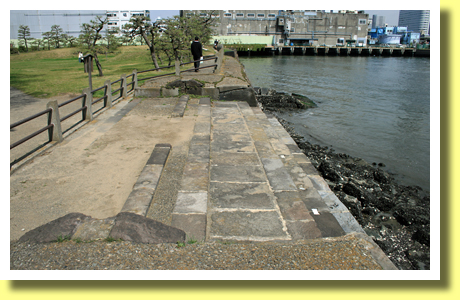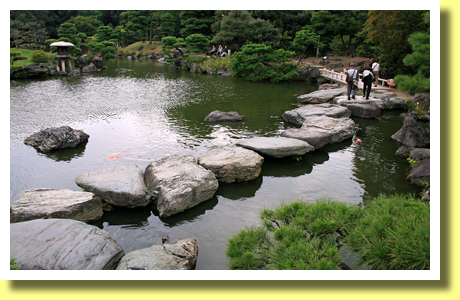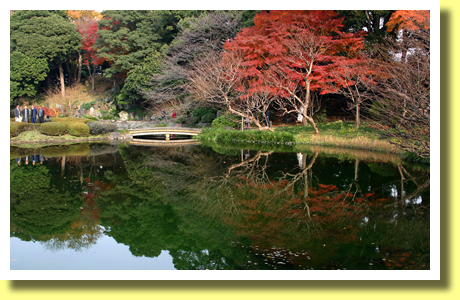|
|
|
|
|
|
|
Achi-Kochi Japan
Showing many places to visit and foods to eat in Japan
|
|
|
|
|
|
|
|
|
|
|
|
|
Japan
> Tokyo region
> Daimyo Gardens
|
|
|
|
|
|
|
Daimyo Gardens
Tokyo ( Achi-Kochi Japan )
|
|
|
|
|
|
|
|
|
|
|
|
|
( "Achi-Kochi" in Japanese means "Here and there" in English. )
|
Hamarikyu Garden

Since Ieyasu Tokugawa established Tokugawa Shogunate in A.D.1603, there had been many residences of Daimyo ( Feudal Lords ) in Edo ( Tokyo now ). In the sites of their residences, Tokugawa Shoguns and Daimyos built gardens such as Hamarikyu Gardens ( above ). Such gardens are called " Daimyo Teien".
In the 17th century, the residence, which had been located in the site of Hamarikyu Gardens, became a villa of Tokugawa shogun's family. Since then on, Tokugawa shoguns renovated the garden in the site of the villa. It is said that the renovation of the garden was completed in the early 19th century.
|
|
Port in Hamarikyu Garden

In Hamarikyu Garden, there remains an old port ( above ) where Tokugawa Shoguns get on and off their boats. In A.D.1868 when Tokugawa Shogunate was overthrown, Yoshinobu Tokugawa, the 15th and last shogun came back from Osaka and got off his war ship at this port.
He surrendered Edo-jo Castle ( now Kokyo, the Imperial Palace ) to the forces sent by Meiji Government and confined himseld in Mito. Then the site of Hamarikyu became the Imperial Villa which was called "Hamarikyu". "Rikyu" in Japanese means "Imperial Villa" while "Hama" does "seashore".
|
|
Cruise Ship ( Water Bus )

In Hamarikyu Garden, there is another port where cruise ships ( water bus ) arrive and leave. The cruise ships connect Hamarikyu and Asakusa. They run several times a day. Viewing from the cruise ships is a fun, especially in the season of Hamami ( Sakura Viewing - above ).
|
|
Rikugien Garden

Rikugien Garden ( above ) is one of the great Daimyo Teiein ( Gardens ). In A.D.1695, Tsunayoshi Tokugawa, the 5th shogun gave the site to one of his influential aides, Yoshiyasu Yanagisawa, who in the site built his residence and garden, which was completed in the early 18th century as a typical Japanese garden.
In A.D.1878 Rikugien Garden was purchased by Yataro Iwasaki, who established Mitsubishi Conglomerate. In A.D.1933 He donated the garden to Tokyo. Then the garden became open to the public.
|
|
Yozakura

Rikugien Garden is closed at 5:00 pm basically. However temporarily it is open until 9:00 pm in the season of Hanami ( Sakura Viewing ) and cherry blossoms are lit up as above. So many people visit the garden after dark to enjoy viewing Yozakura ( Sakura after dark ). Also temporarily the garden is open after dark in the season of autumn leaves, which are also lit up.
|
|
Arisugawa-no-miya Memorial Park

During Tokugawa Period, feudal lords of Morioka Domain built a villa and garden in Edo ( now Tokyo ). In A.D.1896 the villa and garden belonged to Arisugawa-no-miya, a branch of the Imperial Household, who donated the villa and garden to Tokyo in A.D.1934 and Tokyo made the garden open to the public as Arisugawa-no-miya Memorial Garden.
In the garden, very rich in nature, there are hills, slopes, valleys, forests, streams, waterfalls and ponds. Walking paths, log steps and stone bridges in the garden help visitors enjoy viewing various landscapes.
|
|
Kiyosumi Teien ( Garden )

In the late 17th century, the site of Kiyosumi Teien ( Garden - above ) used to be the residence of Bunzaemon Kinokuniya, a famous merchant. The site was transferred to a feudal lord of Sekijuku Domain in the early 18th century and he constructed the residence and the garden.
After Tokugawa Shogunate was overthrown, the garden became ruinous. In A.D.1878, Yataro Iwasaki, the founder of Mitsubishi Conglomerate, purchased and renovated the garden, which was completed in A.D.1891. In A.D.1924, the garden was donated to Tokyo and made open to the public as Kiyosumi Teien in A.D.1932.
In the garden, there are a small mountain, waterless waterfall and pond as well as several thousands of trees. The stepping stones, scattered in the pond, help visitors enjoy viewing landscapes further.
|
|
Shinjuku Gyoen

In A.D.1590 Ieyasu Tokugawa, the founder of Tokugawa Shogunate, moved to Edo ( now Tokyo ) and he gave the land around Shinjuku to his vassal, Kiyonari Naito, whose descendants became feudal lords of Takato Domain in A.D.1691. A part of the land is the site of Shinjuku Gyoen, in which Tamamo-ike ( pond - above ) remains. The pond is a part of Daimyo Teien built by the Naito family in A.D.1772.
After Tokugawa Shogunate was overthrown, the land was transferred to Meiji Government, who completed Shinjuku Gyoen as an Imperial Garden in A.D.1906. During WWII, most of the buildings in the site were destroyed by air raids. In A.D.1949, Shinjuku Gyoen became a national garden, open to the public. In Shinjuku Gyoen, there are not only traditional Japanese garden, but also French and English gardens.
|
|
Ni-no-maru Teien

There is a garden called "Ni-no-maru Teien" ( above ) in a part of Kokyo ( the Imperial Palace ). It is said that in the site of Ni-no-maru Teien, in the 17th century there used to be a garden designed by Enshu Kobori, who was the founder of Japanese landscaping. In A.D.1968 Ni-no-maru teien was restored in the style of Enshu Kobori.
|
If interested in Japanese gardens, Katsura Rikyu ( Imperial Villa ) could be recommended. Katsura Rikyu, located in Kyoto, was built in the 17th century by two imperial princes and there is one of the most beautiful Japanese gardens in the villa.
Copyright (c) 2021 Achi-Kochi Zanmai Co., Ltd.
|








